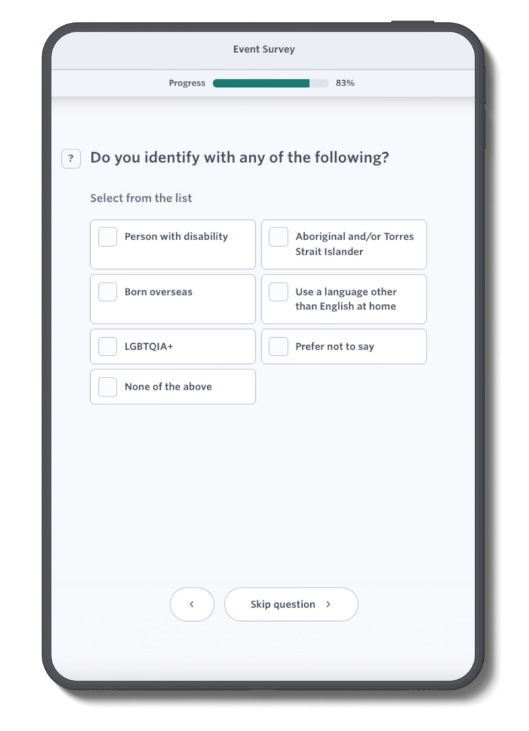Identity can have many meanings, but at its core it relates to a person’s distinctive qualities or traits that make them unique.
‘Identity’ is one of the standardised questions available in the Culture Counts Evaluation Platform Question Bank.
It refers to the characteristics by which people define themselves, such as cultural, social, or personal identifiers. This could include aspects like disability, ethnicity, gender, or other key personal or group characteristics.
The ‘Identity’ question may feel out of context within a greater question set, however there is a wider purpose to this question. The ‘Identity’ question can be used to ‘pivot’ data to gain deeper insights into the experiences of demographic groups that may be underrepresented, and provide specific actionable feedback to increase their engagement and outcomes.

What is data pivoting?
Pivoting data allows you to rearrange your data set to view it from multiple perspectives, such as by age, gender or identity. To read more about how we pivot data in the Analytics Dashboard, click here.
Benefits in using the ‘Identity’ question
So why is asking a person’s identity important? We’ve put together some key benefits this question may offer your organisation:
- Insight into Demographics: Collecting data on age and gender is helpful but only gives an overview of your audience. Giving respondents the opportunity to disclose their identity allows for a greater reporting scope and intersectional data.
- Meeting Key Performance Indicators (KPIs): For many organisations, engaging with people from diverse backgrounds is a key performance indicator. Including an identity question in surveys offers a straightforward method to measure success in this area and can highlight areas of improvement.
- Data-Driven Decision Making: The data collected from these questions can inform organisations on how to improve accessibility and inclusiveness in their programs, by identifying barriers or highlighting areas of success. This is also known as closing the feedback loop or making change, which is the last step of our Six Step Evaluation Process.
- Advocacy for Funding: Understanding the identity of audiences can be instrumental in advocating for future funding, particularly in demonstrating engagement with and impact on diverse groups. The data collected can identify gaps in areas in a tangible way, which organisations can then include in applications to make a compelling argument towards inclusivity.
The addition of this question is ultimately at the discretion of the organisation, depending on its relevance to their reporting and objectives. The decision to include or exclude this question should consider its potential value in understanding and serving diverse audiences effectively.
Exploring our Question Bank database
We explored the Culture Counts database to find out how organisations can use the ‘Identity’ question. The wording of the ‘Identity’ question is designed to be inclusive and is continuously revised to reflect changes in the language surrounding identity.
In particular, we dived into the ‘Identity’ question in relation to the LGBTQIA+ community.
Many LGBTQIA+ organisations seek to measure and report key social and community outcomes – to understand their impact in helping to create healthy, safe, inclusive and connected communities.
Analysis Methodology
We chose a list of dimension statements that are common outcome areas for organisations wanting to assess their inclusivity for audiences of different identity groups.
Dimension statements
- Safe: It made me feel safe and welcome
- Belonging: It helped me feel a part of the community
- Inclusion: It made me feel welcome and included
- Connection: It helped me feel connected to people in the community
By pivoting the ‘Identity’ question results by statements such as ‘Safe’, ‘Belonging’, ‘Inclusion’ and ‘Connection’, we can start to visualise the sentiment around these statements in relation to those who identify as LGBTQIA+.
Do they feel safe and welcome? Do they feel like part of the community? If the averages are quite low, organisations can take this data and use it to make improvements. This may be a matter of applying for more funding to achieve these goals, engaging practitioners from more diverse backgrounds or moving to venues that have a history of being safe and accessible spaces.
In the data sourced from our database, we can see high averages in these four outcome areas.
To ensure the results are rigorous, we have compared the results from two samples – those who selected any of the identity options, and those who identified as LGBTQIA+. This allows for an element of standardisation and control when delving into the data.
The results show a higher average across these outcome areas among LGBTQIA+ respondents. Comparative data between the larger sample and those who identified as LGBTQIA+ show similar results, and the same results for ‘Safe‘ and ‘Inclusion’.

LGBTQIA+ respondents scored 2 points higher on average for ‘Connection’ and ‘Belonging’.
These results suggest that this sample was more likely to agree that the activity they engaged in helped them feel connected to people in the community and feel part of the community as a whole.
The average scores of respondents that identified as LGBTQIA+ for the ‘Safe’ and ‘Inclusion’ dimensions were in line with those of all other respondents.
These results highlight that organisations are achieving success at helping this demographic feel safe, connected and included.
These results, paired with other questions like Overall Experience, Net Promoter Score and anecdotal evidence help paint a full picture of respondent sentiment.
These insights can be gleaned for many other respondent groups. The ‘Identity’ question in the Question Bank provides selection options for those who identify as Aboriginal and/or Torres Strait Islander, those living with disability, those who are born overseas and those who speak a language other than English at home. It is important to ensure you are collecting feedback from a wide range of respondents so you can close the feedback loop and make change accordingly.
Research conducted by Culture Counts Data Analysts Jamie McCullough and Riley Chappell.
Are you interested in finding out more about Culture Counts? Contact us here to organise a chat with our friendly Client Team.







